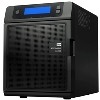Western Digital WDBLGT0080KBK User Manual - Page 35
Managing Storage on the WD Sentinel Server, WD Sentinel Server RAID Storage
 |
View all Western Digital WDBLGT0080KBK manuals
Add to My Manuals
Save this manual to your list of manuals |
Page 35 highlights
MANAGING STORAGE ON THE WD SENTINEL SERVER 5 Managing Storage on the WD Sentinel Server WD Sentinel Server RAID Storage Using USB Storage Replacing a Failed Drive Adding Capacity by Adding a Drive WD Sentinel Server RAID Storage RAID is the acronym for Redundant Array of Independent Disks. The WD Sentinel server provides automatic RAID service to assure the integrity of the storage system. For redundancy, a minimum of two drives must be active. The operating system and all data are protected by the RAID structure. The server automates the management of the RAID. With two drives installed into the system, RAID 1 (mirror) is employed. With three or four drives installed, RAID 5 offers fast performance by striping data across all drives, These RAID levels provide the system with both redundancy and optimum capacity. RAID Level 1 (2 Drives) RAID Level 5 (3 Drives) RAID Level 5 (4 Drives) 2 TB Drives 2 TB Capacity 4 TB Capacity 6 TB Capacity 3 TB Drives 3 TB Capacity 6 TB Capacity 9 TB Capacity If a drive in the array fails, the data and operating system are still intact, and the WD Sentinel server continues to provide service. Important: If you have one bad drive, the server operates normally. However, if a second drive fails, the server will no longer operate. You will need to recover the server and/or replace the failed drive. A best practice is to have a replacement drive readily available. The WD Sentinel server lets you know that a drive has failed in the following ways: „ The message "STORAGE DEGRADED" appears on the WD Sentinel server LCD. „ The LED above the bad drive is solid red. „ The Power LED on the WD Sentinel server flashes red, indicating a serious fault. „ An email Alert is posted if you have set it up to do so. (See "Monitoring System Health and Alerts" on page 22.) To recover from a failed drive, simply replace the drive (the one with the red LED over the bay door) with an approved drive for the WD Sentinel server (see "Find compatible hard drives" on page 24). The WD Sentinel server validates the replaced drive and automatically integrates it into the RAID array. This operation takes many hours to accomplish. Progress of this operation appears on the display as well as on the Dashboard. It is not necessary to power off or disengage the WD Sentinel server WD SENTINEL DX4000 31 ADMINISTRATOR'S MANUAL















